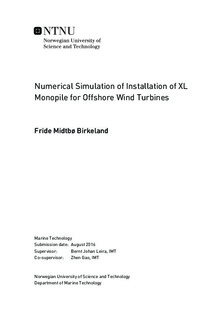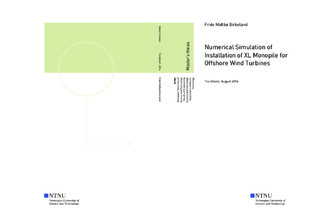| dc.description.abstract | There has to be a significant increase in the share of power supplied by renewable energies to reduce global emission, simultaneously as the wealth is rising in the newly industrialized countries. Wind energy is one of the sustainable resources predicted to provide an increasing share of this power, due to the large extent of untapped resources offshore.
Kiełkiewicz et al. (2015) argue that, with regards to cost per megawatt of rated power, it is more favourable to use higher capacity wind turbines supported on larger piles than to use the turbines commonly used today. Even though the capital costs depend more on the number of structures than the size of the units (BVG Associates (2012)), larger components and a harsher environment do, however, bring more risky and expensive operations. Thus to make offshore wind profitable, at the same time as the structures move further offshore and to deeper waters, the installation procedures have to be optimized.
This thesis addresses numerical simulation of the installation of XL monopile sub- structures for offshore wind turbines. Even if monopiles are the most frequently used support structures, few numerical studies have been performed on installation of these. In this thesis, the behaviour of a coupled installation system composed of a heavy lift- ing vessel and an XL monopile is studied. To predict the responses of this system, a numerical model is established in SIMO and simulations of the lowering phase of the installation are conducted.
The hydrodynamic system properties, used in the dynamic analysis of the system, are obtained from a frequency-domain analysis in HydroD. As these properties are time varying and obtained during steady-state conditions, they cannot be implemented dir- ectly in a non-stationary situation. The common simplification of conducting steady- state simulations in the most onerous position is thus utilized to study the effect of radiation damping from the XL monopile.
The issue connected to the time varying hydrodynamic properties, which occurs when the entire lowering operation is to be simulated, can be solved if strip theory is ap- plied and the potential damping is neglected. Since the radiation damping of the XL monopile might affect the system responses considerably for moderate seas, the sig- nificance of simulating the entire lowering operation rather than conducting stationary simulations at the most intolerable position is also investigated.
From the eigenvalue analysis of the time-invariant model it is found that the XL mono- pile has a strongly depth-dependent natural period in pitch, which varies in the range of approximately T = 3.25 s to T = 4.65 s as the monopile is lowered. The eigenfrequency of the vessel pitch motion is, on the other hand, not affected by the chancing monopile draft and stays steadily at T = 8.89 s.
Regarding the coupled rotational and translational oscillations, the pendulum motions, they have higher eigenperiods than the other rigid body modes. In most sea states, the wave power close to these natural periods is too low to excite the motion. Due to the significant depth-dependency of these natural periods it is, nonetheless, important to investigate these pendulum effects especially at small drafts and in severe sea states, as they might be critical for the operation.
When the difference in the response spectral density obtained by an irregular and a regular wave analysis is investigated, it is found that the response collected from the regular wave analysis either corresponds to or is larger than the irregular analysis re- sponse. If the irregular wave spectrum has a peak which coincides with a resonance frequency, an exception to this tendency is observed. For such cases, the frequency resolution in the regular wave analysis might not be sufficient to capture the peak.
When the spectral peak period corresponds to the eigenfrequency of the motion stud- ied, higher short-term extreme responses and standard deviations are found for the irregular analysis, as expected. If not, the estimated extreme responses is lower for the irregular analysis. The extreme responses in surge are, however, found to be more critical in the irregular wave analysis than in the regular. This deviates from the ex- pectations and implies that a further study of these responses should be conducted.
When the radiation damping effect of the monopile is investigated, a significant re- duction in the rotational resonance motion is observed when the potential damping is included both in short and longer waves. In the Tp = 8 s case, there is a peak in the spectrum corresponding to the spectral peak period of the wave spectrum. For this peak, no reduction is observed. This is due to the fact that this monopile motion is induced through the crane, by the increasing vessel motion, and is not affected by the radiation and diffraction of the monopile.
In the final part the significance of performing complete non-stationary simulations of the operation is investigated. The short-term extreme response in the lift wire, obtained from steady-state simulations at the most onerous position, is compared to the extreme responses obtained from repeated deployments to examine the effect of conducting non-stationary analyses. A significantly higher short-term extreme wire tension is ob- served for the steady-state simulations. This indicates that the simplification of con- ducting stationary simulations overestimates the responses and consequently may re- duce the allowable sea states established for the operation.
In this Master s thesis only a few critical factors for the operation are studied. To ac- curately model the lowering of an XL monopile and establish operational limits on the basis of the obtained system responses, further work is required. Based on the analyses conducted, additional studies should be performed to further verify the results. Before well-founded operational limits can be established, shielding effects, wave spreading and nonlinear loads should also be taken into account. | |

